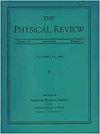Inverse Janus design of two-dimensional Rashba semiconductors
引用次数: 0
Abstract
The search for optimal Rashba semiconductors with large Rashba constants, strong electric field responses, and potential thermoelectric properties is pivotal for spin field-effect transistors (SFETs) and Rashba thermoelectric devices. Herein, we employ first-principles calculations to explore the intrinsic Rashba spin splitting in a series of two-dimensional (2D) $XY{Z}_{2}$ (X, $Y=\mathrm{Si}$, Ge, Sn; $X\ensuremath{\ne}Y$; $Z=\mathrm{P}$, As, Sb, Bi) monolayers via unnatural inverse Janus structural design. Instead of common Janus-type Rashba systems, the $\mathrm{SiSn}{\mathrm{Sb}}_{2}$ and $\mathrm{GeSn}{\mathrm{Sb}}_{2}$ monolayers within inverse Janus structures are first predicted as ideal Rashba systems with isolated spin-splitting bands near the Fermi level, and the Rashba constants ${\ensuremath{\alpha}}_{\mathrm{R}}$ are calculated as 0.94 and $1.27\phantom{\rule{0.16em}{0ex}}\mathrm{eV}\phantom{\rule{0.16em}{0ex}}\AA{}$, respectively. More importantly, the Rashba effect in such $\mathrm{SiSn}{\mathrm{Sb}}_{2}$ and $\mathrm{GeSn}{\mathrm{Sb}}_{2}$ monolayers can be more efficiently modulated by the external electric field compared to the biaxial or uniaxial strain, especially with $\mathrm{GeSn}{\mathrm{Sb}}_{2}$ monolayer exhibiting a strong electric field response rate of $1.34\phantom{\rule{0.16em}{0ex}}\mathrm{e}{\AA{}}^{2}$, leading to a short channel length, $L=64\phantom{\rule{0.16em}{0ex}}\mathrm{nm}$. Additionally, owing to the inapplicability of work function and potential energy in assessing built-in electric field $({E}_{in})$ in inverse Janus $\mathrm{SiSn}{\mathrm{Sb}}_{2}$ and $\mathrm{GeSn}{\mathrm{Sb}}_{2}$ structures, we further propose an effective method to characterize ${E}_{in}$ through a view of fundamental charge transfer to approximately quantize the ${\ensuremath{\alpha}}_{\mathrm{R}}$ and its variation under an external electric field. Our work not only proposes the $\mathrm{GeSn}{\mathrm{Sb}}_{2}$ monolayer acting as a promising multifunctional material for potential applications in SFETs and Rashba thermoelectric devices but also inspires future research to introduce Rashba spin splitting in 2D materials through inverse Janus design.二维Rashba半导体逆Janus设计
寻找具有大Rashba常数、强电场响应和潜在热电性能的最佳Rashba半导体对于自旋场效应晶体管(sfet)和Rashba热电器件至关重要。本文中,我们采用第一性原理计算来探索一系列二维(2D) $XY{Z}_{2}$ (X, $Y=\ mathm {Si}$, Ge, Sn;$ X \ ensuremath {\ ne} Y美元;$Z=\ mathm {P}$, As, Sb, Bi)单分子层非自然逆Janus结构设计。与普通的Janus型Rashba系统不同,本文首先将逆Janus结构中的$\mathrm{SiSn}{\mathrm{Sb}}_{2}$和$\mathrm{GeSn}{\mathrm{Sb}}_{2}$单层预测为在费米能级附近具有孤立自旋分裂带的理想Rashba系统,并计算出Rashba常数${\ensuremath{\alpha}} {\mathrm{R}}$分别为0.94和$1.27\phantom{\rule{0.16em}{0ex}}\mathrm{eV}\phantom{\rule{0.16em}{0ex}}}\AA{}$。更重要的是,与双轴应变或单轴应变相比,$\mathrm{SiSn}{\mathrm{Sb}}_{2}$和$\mathrm{GeSn}}{\mathrm{Sb}}_{2}$单层中的Rashba效应可以更有效地被外电场调制,特别是$\mathrm{GeSn}{\mathrm{Sb}}_{2}$单层的强电场响应率为$1.34\phantom{\rule{0.16em}{0ex}}\mathrm{e}{\AA{}}^{2}$,导致通道长度较短,$L=64\phantom{\rule{0.16em}{0ex}}\mathrm{nm}$。此外,由于在反演Janus $\mathrm{SiSn}{\mathrm{Sb}}{2}$和$\mathrm{GeSn}{\mathrm{Sb}}}{2}$结构中,功函数和势能不适用于评价内置电场$({E}_{in})$,我们进一步提出了一种通过基本电荷转移的观点来表征${E}_{in}$的有效方法,以近似量化${\ensuremath{\alpha}}_{\mathrm{R}}$及其在外电场下的变化。我们的工作不仅提出了$\mathrm{GeSn}{\mathrm{Sb}}{2}$单层作为一种有前途的多功能材料,在sfet和Rashba热电器件中有潜在的应用,而且还启发了未来的研究,通过逆Janus设计在二维材料中引入Rashba自旋分裂。
本文章由计算机程序翻译,如有差异,请以英文原文为准。
求助全文
约1分钟内获得全文
求助全文

 求助内容:
求助内容: 应助结果提醒方式:
应助结果提醒方式:


